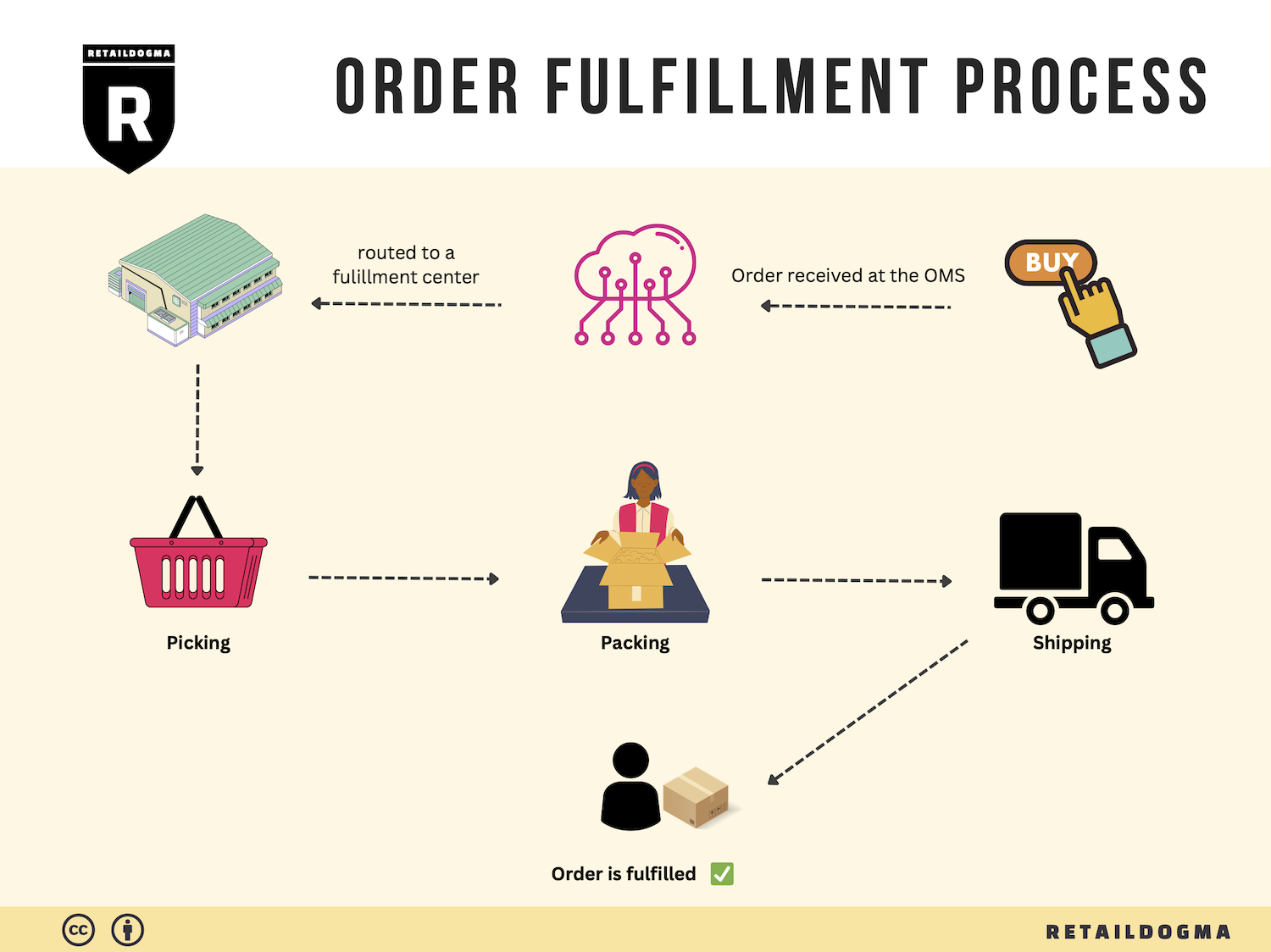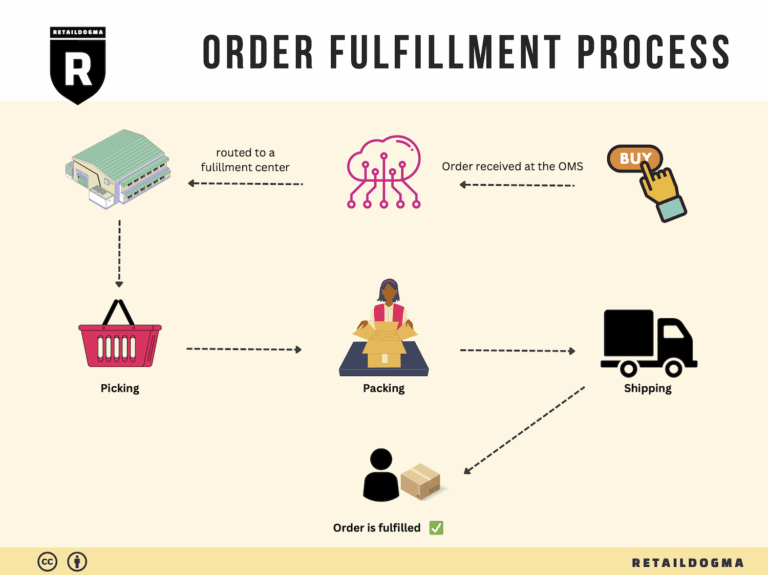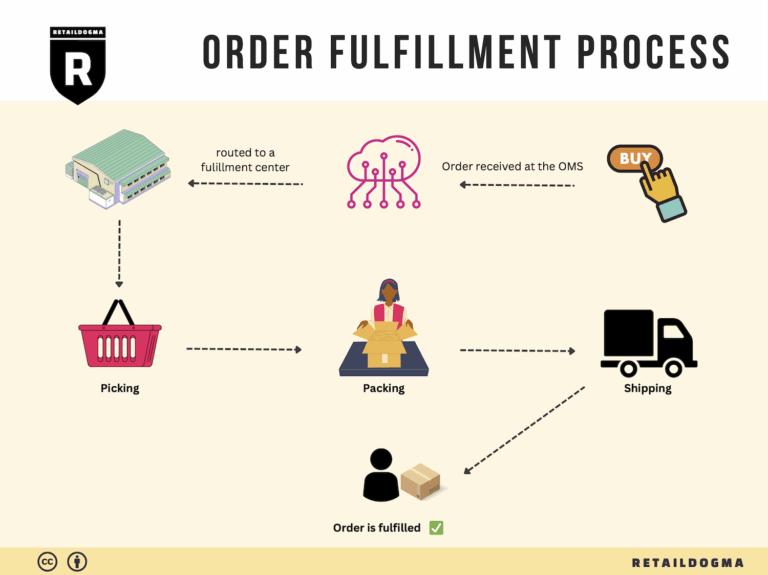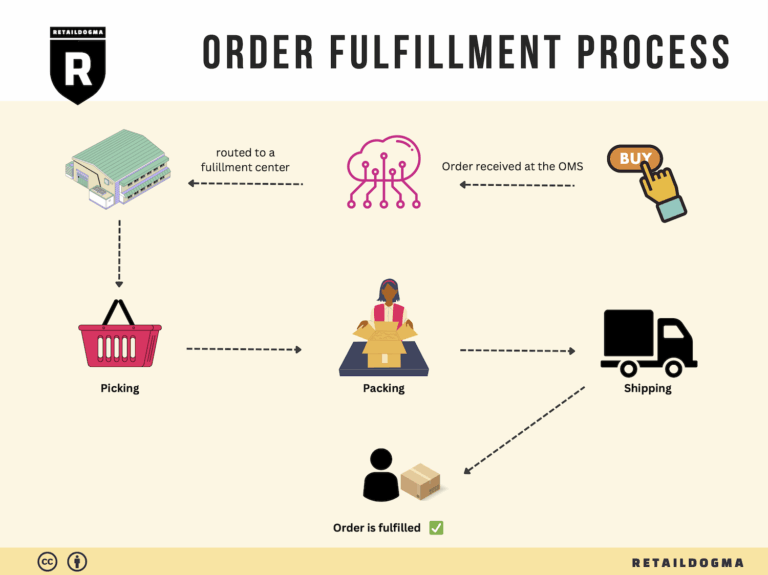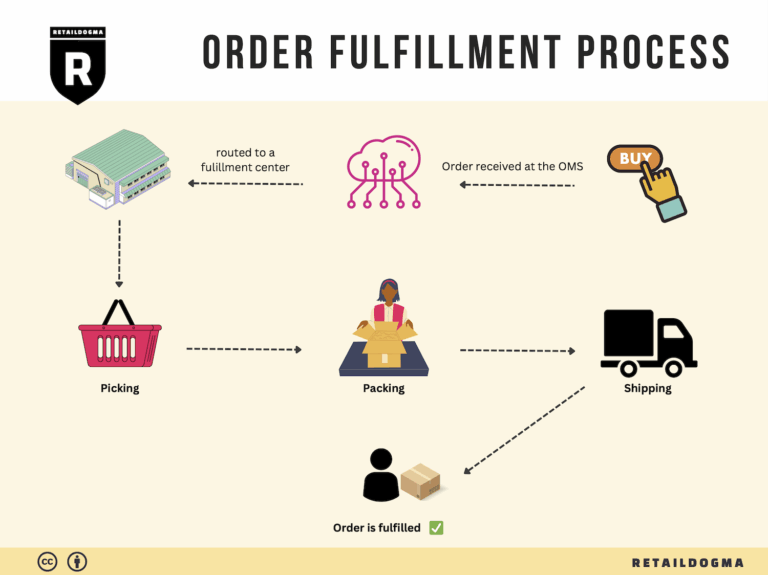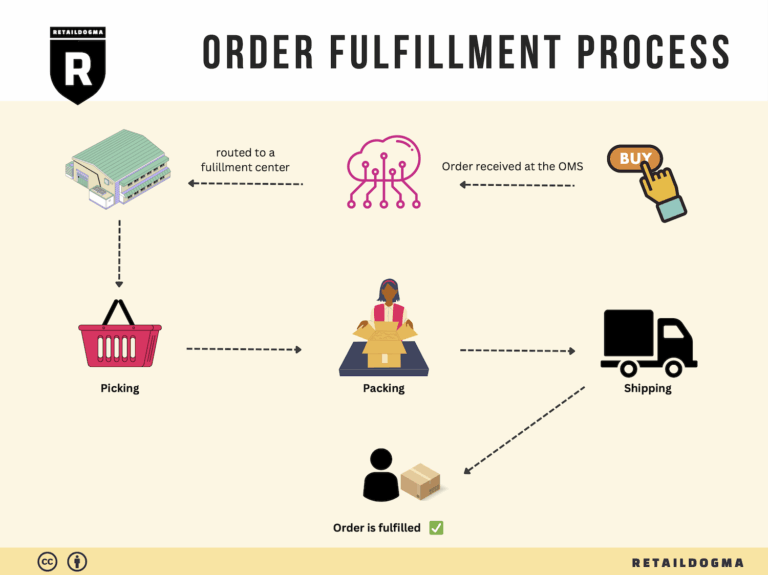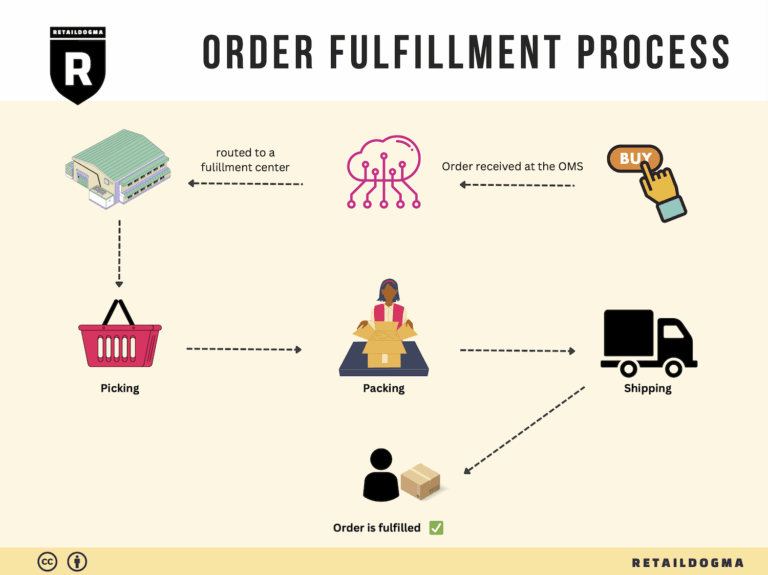What Is A Fulfillment Center? A Complete Guide (2025)
What is E-commerce Fulfillment? An Introduction for Growing Businesses
Understanding the Challenges of Order Fulfillment
For many growing e-commerce businesses, the excitement of scaling sales often comes hand-in-hand with an overwhelming burden: packing and shipping orders. As sales increase, so too does the complexity of fulfilling those orders efficiently and effectively. This crucial process—fulfillment—encompasses everything from inventory management to the final delivery of products to customers. In essence, fulfillment is the backbone of your e-commerce operation, directly impacting customer satisfaction and, ultimately, your bottom line.
Defining E-commerce Fulfillment
At its core, e-commerce fulfillment is the comprehensive process of getting a product from your warehouse or fulfillment center to your customer’s doorstep. It involves various stages, including receiving inventory, managing stock levels, picking items from storage, packing them securely, and arranging for shipping. The goal is to ensure that customers receive their orders accurately and promptly, fostering a positive shopping experience that encourages repeat business.
What This Guide Covers
In this guide, we will delve into the different models of e-commerce fulfillment, such as Third-Party Logistics (3PL) and Fulfillment by Amazon (FBA). We will explore the core services provided by fulfillment partners, including inventory management, order processing, shipping solutions, and returns handling. Understanding these services is essential for businesses looking to streamline their operations and enhance customer satisfaction.
We will also provide practical advice on how to choose the right fulfillment partner for your specific needs. Factors such as scalability, technology integration, and customer service capabilities will be discussed, helping you make informed decisions tailored to your business growth.
Navigating Pricing Structures
Pricing is another critical aspect of fulfillment that we will cover. Different fulfillment partners have varying pricing models, influenced by factors such as order volume, storage needs, and shipping destinations. By understanding these costs, you can better budget your logistics and avoid unexpected expenses.
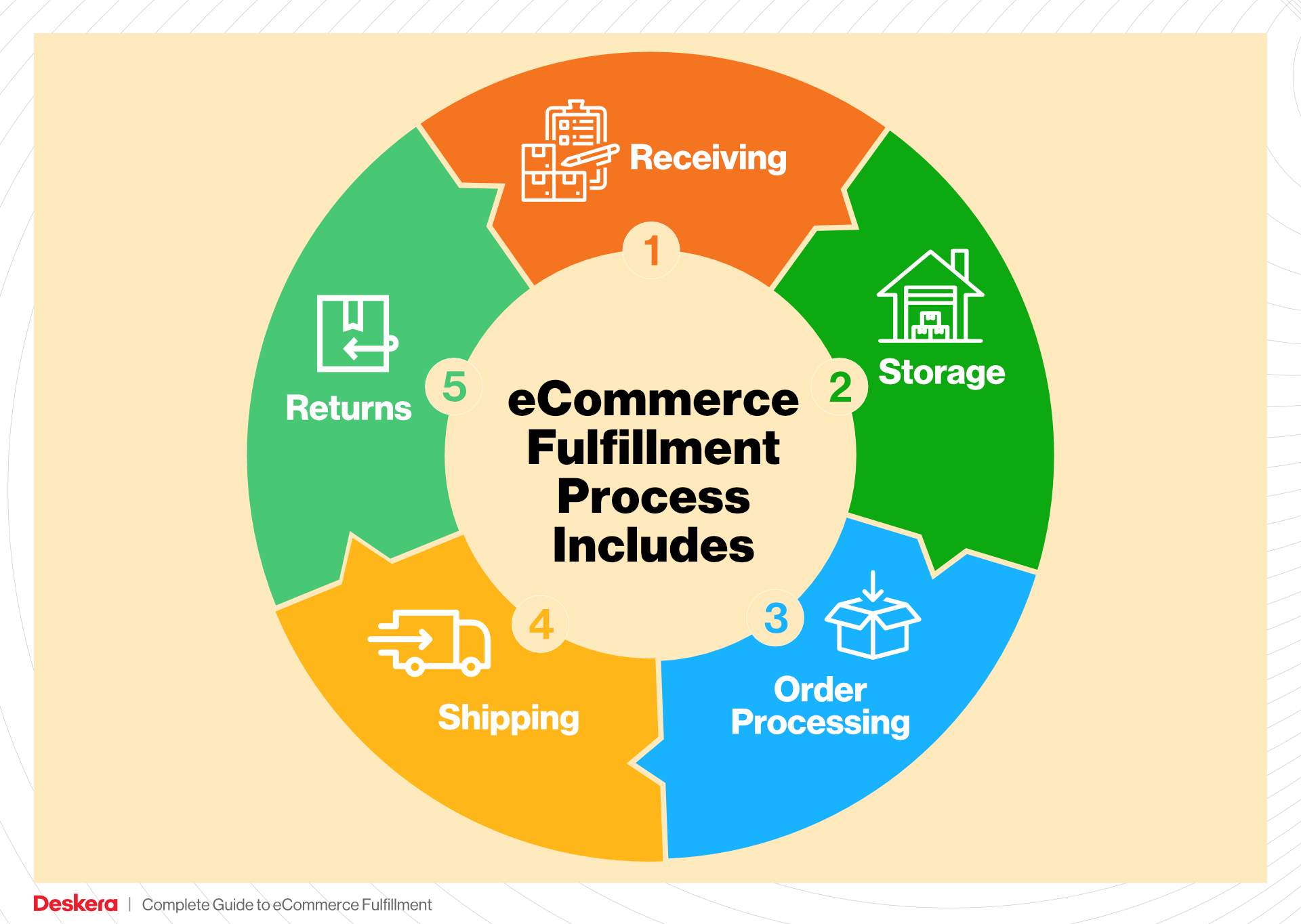
Empowering Your Business Decisions
Ultimately, the goal of this guide is to empower you—whether you are an e-commerce business owner, operations manager, or entrepreneur—to make smart, informed decisions about your logistics strategy. By mastering the intricacies of e-commerce fulfillment, you can position your business for sustainable growth and success in a competitive marketplace.
What You’ll Learn In This Guide
- What is E-commerce Fulfillment? An Introduction for Growing Businesses
- The Order Fulfillment Process: From ‘Buy’ Button to Customer’s Door
- Comparing Fulfillment Models: In-House vs. 3PL vs. Dropshipping
- A Deep Dive into Amazon FBA: Pros, Cons, and Who It’s For
- Core Services Offered by Fulfillment Centers
- How to Choose a Fulfillment Partner: A 6-Point Checklist
- Understanding Fulfillment Pricing: A Breakdown of Common Fees
- Frequently Asked Questions (FAQs) about Fulfillment
- Conclusion: Is Outsourcing Fulfillment the Right Move for Your Business?
- Important Disclaimer
The Order Fulfillment Process: From ‘Buy’ Button to Customer’s Door
1. Receiving Inventory
The order fulfillment process begins with receiving inventory at the fulfillment center. When products arrive, they are checked against the purchase order to ensure the correct items and quantities have been delivered. This step is crucial because it sets the foundation for the entire fulfillment operation. Any discrepancies at this stage can lead to stockouts or excess inventory, which can disrupt sales and customer satisfaction.
A key term associated with this step is SKU (Stock Keeping Unit). Each product is assigned a unique SKU, which helps in tracking inventory throughout the fulfillment process. Efficient receiving processes may also include barcode scanning to streamline inventory management and minimize human error. By ensuring accurate receipt of goods, businesses can maintain optimal inventory levels, which is essential for meeting customer demand effectively.
2. Warehouse Storage
Once the inventory is received and verified, it is moved to designated storage locations within the fulfillment center. This step involves organizing products in a way that maximizes space and enhances accessibility. Proper warehouse storage is vital because it directly impacts the efficiency of order processing in subsequent steps.
Key terms relevant to this phase include ABC Analysis and slotting. ABC Analysis categorizes inventory based on importance and sales velocity, allowing businesses to prioritize storage for fast-moving items. Slotting refers to the strategic placement of products within the warehouse to facilitate quicker picking. By optimizing storage, businesses can reduce retrieval times and enhance overall fulfillment speed, leading to improved customer satisfaction.
3. Order Picking
Order picking is the process of selecting items from storage to fulfill customer orders. When a customer clicks the ‘buy’ button on an e-commerce platform, a pick list is generated, detailing the items needed for that order. This step is critical as it directly affects the accuracy and speed of order fulfillment.

The key term here is pick lists. These documents guide warehouse staff in efficiently locating and retrieving items. Various picking methods can be employed, such as single order picking, batch picking, or zone picking, depending on the volume of orders and the layout of the warehouse. Efficient order picking reduces the time taken to process orders, which is essential for maintaining competitive delivery times and enhancing customer experiences.
4. Order Packing
After items have been picked, they are taken to the packing station for preparation for shipment. This step involves carefully packing the products to prevent damage during transit and may include adding packing materials and creating shipping labels. Order packing is crucial because it not only protects the items but also enhances the unboxing experience for customers.
A relevant term associated with this stage is packing slips. These slips include important information such as the order details and return instructions, ensuring customers have everything they need. Efficient packing processes can also involve the use of automated packing systems, which can speed up the process and reduce labor costs. By ensuring that orders are packed properly, businesses can minimize returns due to damage and improve overall customer satisfaction.
5. Shipping & Delivery
The final step in the order fulfillment process is shipping and delivery. Once orders are packed, they are handed over to shipping carriers for delivery to the customer’s address. This step is critical as it represents the last touchpoint between the business and the customer, significantly impacting the customer’s overall experience.
Key terms to understand in this phase include last-mile delivery and tracking. Last-mile delivery refers to the final leg of the shipping process, where the package is delivered from a distribution center to the end customer. Effective last-mile delivery is essential for ensuring that packages arrive on time. Additionally, providing tracking information allows customers to monitor their orders, enhancing transparency and trust.

In summary, each step in the order fulfillment process—from receiving inventory to shipping and delivery—plays a vital role in the overall success of an e-commerce business. By understanding and optimizing these steps, businesses can improve efficiency, reduce costs, and ultimately enhance customer satisfaction, paving the way for scaling operations successfully.
Comparing Fulfillment Models: In-House vs. 3PL vs. Dropshipping
Fulfillment Models Comparison
| Model | Who Handles Inventory | Best For (Business Stage) | Key Advantage | Key Disadvantage |
|---|---|---|---|---|
| In-House Fulfillment | The e-commerce business itself | Established businesses with stable sales | Full control over operations and quality | High overhead costs and resource-intensive |
| Third-Party Logistics (3PL) | An external logistics provider | Growing businesses looking to scale | Access to expertise and scalable solutions | Less control over operations and potential communication issues |
| Dropshipping | Supplier or manufacturer | Startups and small businesses | Low upfront investment and no inventory risk | Lower profit margins and reliance on supplier reliability |
In-House Fulfillment
In-house fulfillment involves managing the entire logistics process within the business itself. This model is typically adopted by established e-commerce companies that have developed a stable customer base and consistent order volume. By handling inventory, storage, picking, packing, and shipping internally, businesses maintain complete control over their operations. This control extends to product quality, order accuracy, and customer service, allowing for tailored experiences that can enhance customer loyalty. However, in-house fulfillment comes with significant challenges, such as high overhead costs related to warehousing, labor, and technology investments. Additionally, it requires a substantial time commitment and resources to manage logistics effectively, which can divert focus from core business activities like marketing and product development.
Third-Party Logistics (3PL)
Third-party logistics (3PL) companies provide a comprehensive suite of services that enable e-commerce businesses to outsource their fulfillment processes. This model is ideal for growing businesses that are looking to scale their operations without the burden of managing logistics in-house. 3PL providers handle everything from inventory management and order processing to shipping and returns, allowing businesses to focus on their core competencies. One of the key advantages of using a 3PL is the ability to leverage their expertise and established infrastructure, which can lead to improved shipping times, cost savings, and enhanced customer satisfaction. However, businesses may face challenges with communication and control, as they rely on an external provider to manage critical aspects of their logistics. Moreover, choosing the wrong 3PL can lead to operational inefficiencies and negatively impact customer experiences.
Dropshipping
Dropshipping is a fulfillment model where the retailer does not hold inventory but instead transfers customer orders directly to the supplier, who then ships the products to the customer. This model is particularly advantageous for startups and small businesses with limited capital, as it eliminates the need for upfront inventory investment and reduces financial risk. With dropshipping, entrepreneurs can offer a wide range of products without the burden of managing stock, warehousing, or shipping logistics. However, dropshipping has its downsides, including lower profit margins due to wholesale pricing from suppliers and a reliance on supplier reliability for order fulfillment. Any delays or errors made by the supplier can directly impact customer satisfaction and brand reputation. Additionally, the lack of inventory control can make it challenging to manage product availability and quality, requiring businesses to carefully vet their suppliers to ensure a positive customer experience.
Conclusion
Choosing the right fulfillment model is crucial for e-commerce businesses looking to scale effectively. Each model—In-House Fulfillment, Third-Party Logistics, and Dropshipping—offers unique advantages and challenges that can significantly impact operations, customer satisfaction, and profitability. By carefully assessing their business stage, resources, and long-term goals, e-commerce owners can make informed decisions that align with their operational needs and customer expectations.
A Deep Dive into Amazon FBA: Pros, Cons, and Who It’s For
Understanding Fulfillment by Amazon (FBA)
Fulfillment by Amazon (FBA) is a service offered by Amazon that allows e-commerce businesses to utilize Amazon’s extensive logistics network to store, pack, and ship their products. By leveraging FBA, sellers can benefit from Amazon’s vast customer base and advanced fulfillment capabilities, streamlining their operations and enhancing customer satisfaction.
How FBA Works
The FBA process begins when a seller creates an Amazon seller account and enrolls in the FBA program. Sellers then ship their products to Amazon’s fulfillment centers, where the items are stored until they are sold. When a customer places an order for a product, Amazon takes care of the entire fulfillment process, which includes:
- Storage: Products are stored in Amazon’s warehouses until sold.
- Order Processing: When an order is received, Amazon picks the item from the shelf, packs it, and prepares it for shipment.
- Shipping: Amazon handles the shipping process, utilizing its vast logistics network to deliver items quickly to customers.
- Customer Service: FBA also includes customer service and returns handling, allowing sellers to focus on other aspects of their business.
In addition to these services, FBA products are eligible for Amazon Prime, which can significantly increase visibility and sales potential.
Pros of Using FBA
-
Prime Eligibility: One of the most significant advantages of using FBA is that products become eligible for Amazon Prime. This status can greatly enhance a product’s visibility and appeal, as Prime members often prefer items with quick, free shipping.
-
Customer Trust: Leveraging Amazon’s brand provides sellers with increased credibility. Customers are more likely to purchase items fulfilled by Amazon due to the trusted reputation of the platform.
-
Multi-Channel Fulfillment: FBA allows sellers to fulfill orders not only from Amazon but also from other e-commerce platforms. This multi-channel fulfillment capability provides flexibility and a streamlined process for managing orders across various sales channels.
-
Scalability: As businesses grow, FBA can help manage increased order volumes without the need for additional warehousing or logistics staff. Amazon’s infrastructure allows sellers to scale their operations efficiently.
-
Comprehensive Logistics Management: FBA takes care of all logistics operations, including inventory management, packing, shipping, and returns. This allows sellers to focus on product development and marketing rather than operational challenges.
Cons of Using FBA
-
High Fees: While FBA provides numerous benefits, it also comes with significant costs. Sellers must pay for storage fees and fulfillment fees, which can eat into profit margins, especially for lower-priced items or those with slow turnover rates.
-
Strict Inventory Rules: Amazon has stringent inventory management policies, including limitations on the number of units that can be stored at their fulfillment centers. This can be challenging for sellers with seasonal or fluctuating inventory levels.
-
Commingling Risks: FBA operates on a commingling model, meaning that products from different sellers may be stored together. This can lead to issues if customers receive the wrong item or if there are quality control concerns.
-
Loss of Control: By outsourcing fulfillment to Amazon, sellers relinquish some control over the customer experience. Any issues with shipping, handling, or returns are managed by Amazon, which may not always align with the seller’s brand standards.
-
Dependency on Amazon: Relying on FBA means that sellers are at the mercy of Amazon’s policies and changes. Any alterations in fees, fulfillment processes, or platform rules can significantly impact a seller’s business.
Who is FBA Best For?
Fulfillment by Amazon is best suited for e-commerce businesses that want to leverage Amazon’s extensive logistics network and customer base while minimizing the operational burdens associated with order fulfillment. Specifically, FBA is ideal for:
-
Small to Medium-Sized Businesses: Those looking to scale quickly without investing heavily in their own logistics infrastructure can benefit from FBA’s resources.
-
Sellers with High-Volume Products: Businesses with products that sell consistently can take advantage of FBA’s efficient fulfillment services and potentially offset the costs through volume sales.
-
Brands Seeking Prime Access: Companies aiming to attract Amazon Prime members will find FBA essential, as it provides the necessary eligibility for Prime shipping.
-
Multi-Channel Sellers: Businesses selling across multiple platforms can utilize FBA for seamless order fulfillment, simplifying logistics while expanding their reach.
In conclusion, while FBA offers significant advantages in terms of efficiency and access to Amazon’s customer base, it is essential for sellers to carefully weigh the costs and operational implications before fully committing. Understanding your business model, product types, and sales volume will help determine if FBA aligns with your growth strategy.
Core Services Offered by Fulfillment Centers
Inventory Management & Warehousing
Inventory management and warehousing are the foundational services provided by fulfillment centers. This process involves the systematic tracking of inventory levels, orders, sales, and deliveries. Fulfillment centers utilize advanced software solutions to monitor stock in real-time, ensuring that e-commerce businesses can maintain optimal inventory levels and avoid stockouts or overstock situations.
The benefits of effective inventory management are multifaceted. For e-commerce businesses, accurate inventory tracking minimizes the risk of running out of popular products, which can lead to lost sales and dissatisfied customers. Additionally, well-managed warehousing allows for efficient space utilization, which can reduce costs associated with storage. By leveraging a fulfillment center’s expertise in inventory management, businesses can focus on their core operations, such as product development and marketing, rather than getting bogged down by logistical concerns.
Pick and Pack Services
Pick and pack services are a critical component of the fulfillment process. This service involves selecting items from the warehouse shelves (picking) and preparing them for shipment (packing). Fulfillment centers employ various strategies to optimize this process, such as batch picking or zone picking, which can significantly reduce order processing times.
The advantages of efficient pick and pack services are significant for e-commerce businesses. Speed and accuracy in order fulfillment directly impact customer satisfaction. Quick order turnaround times enhance the overall shopping experience, leading to increased customer loyalty and repeat purchases. Furthermore, fulfillment centers often use sophisticated packing techniques to ensure that products are safely packaged, reducing the likelihood of damage during shipping. This not only protects the business’s bottom line but also reinforces a positive brand image among consumers.
Kitting and Assembly
Kitting and assembly involve combining multiple products into a single package or kit before shipping. This service is particularly beneficial for e-commerce businesses that sell bundled products, promotional items, or custom orders. Fulfillment centers can assemble these kits according to specific customer requirements, ensuring that each order is tailored to meet consumer needs.
The primary benefit of kitting and assembly services is the ability to offer unique product combinations that enhance the customer experience. By providing bundled items, businesses can increase average order value and encourage upselling. Moreover, outsourcing this service to a fulfillment center allows businesses to streamline their operations. Instead of dedicating resources to assembling products in-house, companies can focus on growth strategies and customer engagement, knowing that their fulfillment partner is efficiently handling the logistics.
Returns Management (Reverse Logistics)
Returns management, also known as reverse logistics, is an essential service provided by fulfillment centers that can significantly impact customer satisfaction and retention. This process involves handling returned merchandise, assessing its condition, restocking items, and managing the logistics of returns in a seamless manner. Fulfillment centers utilize robust systems to track returned items and process refunds or exchanges efficiently.
The benefits of effective returns management are profound for e-commerce businesses. A streamlined returns process not only enhances the customer experience but also builds trust and loyalty. Consumers are more likely to purchase from a retailer that offers a hassle-free return policy. By utilizing a fulfillment center’s expertise in managing returns, businesses can reduce the operational burden associated with processing returns and focus on driving sales. Additionally, efficient returns management can lead to improved inventory control, as returned items can be quickly assessed and restocked, minimizing losses.
By leveraging the core services offered by fulfillment centers, e-commerce businesses can enhance their operational efficiency, improve customer satisfaction, and ultimately drive sales growth. Whether it’s through robust inventory management, efficient pick and pack services, tailored kitting solutions, or streamlined returns management, partnering with a reputable fulfillment center can provide the competitive edge needed in today’s dynamic e-commerce landscape.
How to Choose a Fulfillment Partner: A 6-Point Checklist
Location & Warehouse Network
Importance:
The geographic location of your fulfillment partner’s warehouses can significantly impact shipping times and costs. A partner with a well-distributed network of warehouses can ensure faster delivery to a larger customer base, enhancing customer satisfaction and potentially lowering shipping expenses.
Questions to Ask:
– Where are your warehouses located, and how many do you operate?
– How do you determine the best warehouse for shipping an order?
– Can you accommodate our target markets with your current network?
– Do you have plans for expanding your warehouse network in the future?
Technology & Integrations
Importance:
In today’s digital landscape, efficient order processing relies heavily on technology. A fulfillment partner should offer robust software solutions that integrate seamlessly with your e-commerce platform, inventory management system, and CRM tools. This integration minimizes errors, streamlines operations, and enhances visibility across the supply chain.
Questions to Ask:
– What technology platforms do you use for order management, inventory tracking, and reporting?
– How do your systems integrate with popular e-commerce platforms like Shopify, WooCommerce, or Amazon?
– Can you provide real-time tracking for orders, and how is this information shared with us and our customers?
– What features do you offer for managing returns and exchanges through your system?
Specializations (e.g., Cold Storage, Oversized Items)
Importance:
Depending on your product range, you may require specialized services. If you deal with perishables, fragile items, or oversized products, ensure that your fulfillment partner has the necessary capabilities. Specializations can affect not only the handling and storage of your products but also compliance with regulations in specific industries.
Questions to Ask:
– Do you offer specialized services such as cold storage, hazardous materials handling, or oversized item fulfillment?
– What experience do you have with products similar to ours?
– How do you ensure compliance with industry regulations for specialized items?
– Can you provide case studies or references from similar clients?
Scalability & Capacity
Importance:
As your business grows, your fulfillment partner must be able to scale operations accordingly. A partner with adequate capacity can handle seasonal spikes in order volume or support your expansion into new markets without compromising service quality.
Questions to Ask:
– How do you manage fluctuations in order volume during peak seasons?
– What is your capacity for handling our current and projected order volumes?
– Can you quickly ramp up operations if our sales increase unexpectedly?
– What are your policies on long-term contracts versus flexibility for growth?
Pricing and Contracts
Importance:
Understanding the pricing structure and contract terms of a fulfillment partner is crucial for financial planning. Look for transparency in pricing and ensure that there are no hidden fees that could impact your bottom line. Contracts should also allow for flexibility as your business evolves.
Questions to Ask:
– Can you provide a detailed breakdown of your pricing model, including storage, pick and pack, and shipping costs?
– Are there any additional fees we should be aware of, such as for returns or special handling?
– What are the terms of your contracts, and do you offer flexibility for scaling up or down?
– How often do you reassess pricing, and what factors could lead to changes?
Customer Support & Reviews
Importance:
A fulfilling partnership is built on strong communication and support. The quality of customer service provided by your fulfillment partner can significantly impact your operations, especially when issues arise. Researching reviews and testimonials can provide insight into their reliability and responsiveness.
Questions to Ask:
– What customer support services do you offer, and how can we reach you in case of emergencies?
– Can you provide references or case studies from current clients?
– How do you handle disputes or issues related to fulfillment, and what is your escalation process?
– What feedback mechanisms do you have in place to ensure continuous improvement?
Conclusion
Choosing the right 3PL fulfillment partner is a pivotal decision for any e-commerce business. By carefully evaluating these six critical areas—Location & Warehouse Network, Technology & Integrations, Specializations, Scalability & Capacity, Pricing and Contracts, and Customer Support & Reviews—you can ensure that your chosen partner aligns with your business goals and can support your growth effectively. Engaging with potential partners through these questions will not only help you gather essential information but also foster a collaborative relationship that can lead to long-term success.
Understanding Fulfillment Pricing: A Breakdown of Common Fees
Initial Setup Fees
When partnering with a third-party logistics (3PL) provider, initial setup fees are often the first costs you’ll encounter. These fees cover the administrative and operational costs associated with onboarding your business into the 3PL’s system. Initial setup may include creating your account, integrating your e-commerce platform, and configuring inventory management systems.
Setup fees can vary significantly based on the complexity of your operations. For example, businesses with a large number of SKUs or those requiring custom software integrations might face higher fees. On average, expect to pay between $100 to $1,000, depending on the provider and the extent of services required. Always clarify what is included in the setup fee to avoid unexpected costs later.
Receiving Fees
Receiving fees are charged when your inventory arrives at the fulfillment center. This fee typically covers the labor and equipment needed to unload, inspect, and store your products. The cost can vary based on factors like the volume of goods received, the type of products (e.g., heavy or fragile items), and whether any special handling is necessary.
Most 3PL companies will charge a per-pallet or per-sku fee for receiving. For example, you might see rates ranging from $5 to $15 per pallet, while per-sku fees can be around $0.50 to $2.00. To ensure accuracy in budgeting, inquire about the specifics of how receiving fees are calculated and whether any discounts are available for larger shipments.
Storage Fees (per pallet/bin)
Storage fees are charged for the space your products occupy within the fulfillment center. These fees can be calculated either on a per-pallet or per-bin basis and are typically billed monthly. The rate usually depends on the location of the warehouse, the type of storage required, and the overall volume of goods stored.
For instance, storage fees might range from $10 to $25 per pallet per month, while bin storage could be priced at $1 to $5 per bin per month. Additionally, some 3PLs may offer tiered pricing, where the cost per pallet decreases as you store larger volumes. It’s crucial to understand how long your inventory is likely to stay in storage, as prolonged storage may incur additional long-term fees.
Pick & Pack Fees (per item/order)
Pick and pack fees are incurred every time an order is processed. This fee covers the labor involved in picking items from storage, packing them for shipment, and preparing them for delivery. The calculation of this fee can be based on either the number of items in an order or a flat fee per order.
For example, you might encounter a fee structure that charges $1 to $5 per order plus $0.20 to $1.00 for each item picked. It’s essential to discuss your average order size and frequency with your 3PL to get a more tailored estimate. Also, inquire about any discounts for high-volume orders, as many providers offer reduced rates for businesses that consistently ship large quantities.
Shipping Fees
Shipping fees are one of the most variable costs in fulfillment pricing. These fees depend on factors like the weight and dimensions of the package, the shipping method (e.g., standard, expedited), and the destination. Many 3PL providers have relationships with major carriers, allowing them to negotiate better rates that can be passed on to you.
Shipping fees can be structured in various ways, such as flat-rate shipping, weight-based pricing, or distance-based pricing. For example, shipping a small package might cost $5, while larger or heavier items could range from $10 to $50 or more, depending on the carrier and service level. To manage costs effectively, ask your 3PL about their shipping partners and any available shipping discounts.
Tips for Getting an Accurate Quote
-
Provide Detailed Information: When requesting a quote, supply as much information as possible about your inventory, order volume, and any specific requirements. This will help the 3PL provide a more accurate estimate.
-
Ask About Additional Fees: Inquire about all potential fees beyond the basics, such as returns processing, special packaging, or seasonal surcharges. Understanding the full scope of fees will help you budget more effectively.
-
Request a Breakdown: Ask for a detailed breakdown of the pricing model. Knowing how each fee is calculated will help you identify areas where you might save costs.
-
Compare Multiple Providers: Don’t settle for the first quote you receive. Comparing several 3PL providers will give you a clearer picture of the market and help you find the best value.
-
Negotiate Terms: If you have a high volume of business, use that leverage to negotiate better rates or terms. Many providers are willing to adjust their pricing based on the potential for long-term partnership.
By understanding these common fulfillment pricing models and following these tips, e-commerce businesses can make informed decisions when selecting a 3PL provider, ultimately leading to enhanced operational efficiency and improved customer satisfaction.
Frequently Asked Questions (FAQs) about Fulfillment
1. What is a 3PL fulfillment company?
A 3PL (Third-Party Logistics) fulfillment company provides a range of logistics services, including warehousing, order processing, packing, shipping, and returns management. By outsourcing these functions, e-commerce businesses can focus on core activities like product development and marketing while benefiting from the expertise of logistics professionals.
2. How does a fulfillment center operate?
A fulfillment center operates by receiving inventory, storing it until orders are placed, and then picking, packing, and shipping those orders to customers. This process often integrates with e-commerce platforms, automating order management and providing real-time tracking to enhance efficiency and customer satisfaction.
3. What’s the difference between a warehouse and a fulfillment center?
While both warehouses and fulfillment centers store goods, their purposes differ significantly. Warehouses primarily focus on long-term storage of products, whereas fulfillment centers are dynamic hubs designed for quick turnover, handling order processing, packing, and shipping to meet customer demands promptly.
4. How much do fulfillment services cost?
The cost of fulfillment services varies based on several factors, including the volume of orders, size and weight of products, storage needs, and specific services required (like kitting or returns management). Typically, fulfillment costs are calculated based on a combination of storage fees, picking and packing fees, and shipping costs.
5. What services do 3PL companies offer?
3PL companies offer a comprehensive suite of services that may include warehousing, inventory management, order fulfillment, shipping and logistics, customs clearance, freight forwarding, and returns handling. Some also provide additional services like technology integration and customer support.
6. How can a 3PL fulfillment company benefit my e-commerce business?
By partnering with a 3PL fulfillment company, e-commerce businesses can streamline their operations, reduce overhead costs, enhance shipping speed and accuracy, and improve customer satisfaction. This allows businesses to scale effectively without the need for extensive in-house logistics capabilities.
7. Is outsourced fulfillment the same as using a 3PL?
Yes, outsourced fulfillment typically involves engaging a 3PL provider to manage inventory, order processing, and shipping tasks. While the terms are often used interchangeably, outsourced fulfillment emphasizes the transfer of logistics responsibilities to an external party, whereas 3PL encompasses a broader range of logistics services.
8. How do I choose the right 3PL fulfillment company?
Choosing the right 3PL fulfillment company involves assessing your specific business needs, evaluating potential partners based on their service offerings, technology integration, pricing, and customer reviews. It’s also important to consider their geographical reach and ability to scale with your business.
9. What technology do 3PL companies use?
3PL companies utilize various technologies to enhance efficiency, including warehouse management systems (WMS), inventory management software, order management systems (OMS), and real-time tracking tools. These technologies help automate processes, improve accuracy, and provide valuable insights into inventory and shipping performance.
10. Can 3PL companies handle returns management?
Yes, many 3PL fulfillment companies offer returns management services. This includes processing returned items, restocking inventory, and handling customer communications related to returns. Efficient returns management is crucial for maintaining customer satisfaction and can help e-commerce businesses manage their return rates effectively.
Conclusion: Is Outsourcing Fulfillment the Right Move for Your Business?
Evaluating the Benefits of Outsourcing Fulfillment
Outsourcing fulfillment can be a transformative decision for e-commerce businesses, offering a multitude of benefits that enable growth and efficiency. One of the most significant advantages is time savings. By entrusting a third-party logistics (3PL) provider with order management, inventory handling, and shipping, you free up valuable hours that can be redirected toward enhancing product development, marketing strategies, and customer engagement.
Scalability is another key benefit. As your business grows, managing logistics in-house can become overwhelming. A reliable 3PL partner can seamlessly adjust to fluctuations in order volume, ensuring that you can meet customer demand without the burden of expanding your operational infrastructure. This flexibility allows businesses to focus on core competencies while leaving logistics to the experts.
Moreover, 3PLs bring specialized expertise and advanced technology into the mix. With their in-depth knowledge of logistics and supply chain management, they can implement best practices that optimize fulfillment processes, reduce shipping costs, and enhance overall customer satisfaction. Their established relationships with carriers often lead to better rates and more efficient shipping solutions, which can be a game-changer for your bottom line.
However, the success of outsourcing fulfillment hinges on selecting the right partner. It’s essential to conduct thorough research and consider factors such as service offerings, technology integration, and customer support. A well-chosen fulfillment partner can accelerate your growth trajectory and enhance your operational efficiency.
Take Action Now
To determine if outsourcing fulfillment is the right move for your business, start with an audit of your current shipping process. Analyze your fulfillment costs, delivery times, and customer feedback. This assessment will provide clarity on whether a 3PL partnership could streamline your operations and drive greater success. Don’t hesitate to explore your options—your next strategic move could redefine your business growth.
Important Disclaimer
⚠️ Important Disclaimer
The information in this guide is for educational purposes. Fulfillment services, pricing, and platform features change frequently. Always conduct your own due diligence and consult with providers directly before making business decisions.
